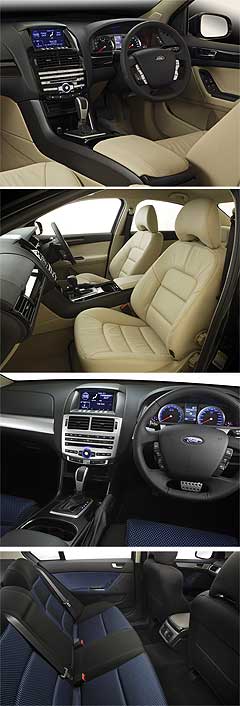Future models - Ford - FalconFG Falcon: A better packaged interiorMore head space: The classy new XR6 Turbo interior. Wider door openings are just the start of the FG Falcon's interior packaging story17 Feb 2008 THE new Falcon has a more spacious interior and will be easier to get in and out of. After copping criticism from customers sick having to bend or twist their way into a Falcon, the car-maker has made sure the new FG is much easier to live with than the AU through to BF models. The door frames are larger and the doors open wider, while the sloping C-pillar has been re-designed so that it doesn’t intrude like it did for the previous Falcons. Improving ingress and egress was an important part of FG Falcon packaging, but the design team has also expanded the interior space even though the car’s exterior size has not increased by much. Ford is claiming the FG Falcon has the most head room, hip room and shoulder room in its class. It also said the new Falcon has the safest body structure of all Australian-made vehicles. Visibility for the driver and occupants was a major focus of Ford designers and the A-pillars came in for special attention. Ford said the redesigned A-pillars have been “optimised in terms of thickness and shape to reduce driver vision obscuration,” which means the surface facing the driver is narrower and therefore makes it easer for them to see round.  From top: Leather-clad G6E interior and XR6 Turbo (below). From top: Leather-clad G6E interior and XR6 Turbo (below).While interior visibility can be hard to measure, Ford said it believed the new Falcon was best-in-class in this regard. The new doors are flatter in design, unlike the overly curved doors of the AU-BF models, which frees up a lot of interior space for the designers to play with. Ford said the rear head room had increased by 13mm, front shoulder room is up by 10mm, rear shoulder room increases by 24mm and front and rear hip-room has increased by 25mm and 22mm respectively. The swing-open angle of the front doors has increased by 5.5 degrees and the swing angle of the rear doors has increased by 8.5 degrees. Ford said its luggage area is also the biggest in its class, with the boot capacity measured at 535 litres when the vehicle is fitted with the standard space-saver wheel. The optional full-size spare wheel, for which Holden's VE Commodore was criticised at launch, will fit in the wheel well, reducing boot space by 30 litres. Unlike its main rival, the Falcon features 60/40-split folding rear seat on all models. The boot can now be opened using an electronically-controlled soft touch pad located just below the Ford badge on the boot. New pull-type door-handles replace this existing top-hinged items for the first time on a Falcon, which Ford says require less effort. Designers also worked to improve the ergonomics for the driver. The gearlever has been raised and angled so that it is closer to the driver for improved comfort, while the centre armrest has also been raised to better support the driver’s arm. A redesigned parking brake lever has been developed with a self-adjusting mechanism Ford says requires less effort to operate. Ford has also redesigned much of the switchgear to improve ease-of-use and feel. “The material, surface textures, weighting and feedback of each control is varied depending on its function, providing quick identification of the control function for improved cabin feedback,” said Ford Australia vehicle package and ergonomics supervisor, David Walton. Read more:FG Falcon: Inline Aussie six's final swansongFG Falcon: No FG wagon - yet FG Falcon: Ford goes to finishing school FG Falcon: Engineered to lead All future models Alfa Romeo Alfa Romeo Abarth Abarth Audi Audi Aston Martin Aston Martin BMW BMW Bentley Bentley Chrysler Chrysler Chevrolet Chevrolet Dodge Dodge Citroen Citroen Ferrari Ferrari DS DS Ford Ford Fiat Fiat FPV FPV Foton Foton Haval Haval Great Wall Great Wall Honda Honda Holden Holden Hyundai Hyundai HSV HSV Isuzu Isuzu Infiniti Infiniti Jeep Jeep Jaguar Jaguar Lamborghini Lamborghini Kia Kia Lexus Lexus Land Rover Land Rover Mazda Mazda Maserati Maserati Mercedes-Benz Mercedes-Benz McLaren McLaren Mini Mini Nissan Nissan Mitsubishi Mitsubishi Peugeot Peugeot Opel Opel Proton Proton Porsche Porsche Renault Renault Ram Ram Saab Saab Rolls-Royce Rolls-Royce Smart Smart Skoda Skoda Subaru Subaru SsangYong SsangYong Tesla Tesla Suzuki Suzuki Toyota Toyota Volvo VolvoMotor industry news |
Click to shareFord modelsResearch Ford All future models Alfa Romeo Alfa Romeo Abarth Abarth Audi Audi Aston Martin Aston Martin BMW BMW Bentley Bentley Chrysler Chrysler Chevrolet Chevrolet Dodge Dodge Citroen Citroen Ferrari Ferrari DS DS Ford Ford Fiat Fiat FPV FPV Foton Foton Haval Haval Great Wall Great Wall Honda Honda Holden Holden Hyundai Hyundai HSV HSV Isuzu Isuzu Infiniti Infiniti Jeep Jeep Jaguar Jaguar Lamborghini Lamborghini Kia Kia Lexus Lexus Land Rover Land Rover Mazda Mazda Maserati Maserati Mercedes-Benz Mercedes-Benz McLaren McLaren Mini Mini Nissan Nissan Mitsubishi Mitsubishi Peugeot Peugeot Opel Opel Proton Proton Porsche Porsche Renault Renault Ram Ram Saab Saab Rolls-Royce Rolls-Royce Smart Smart Skoda Skoda Subaru Subaru SsangYong SsangYong Tesla Tesla Suzuki Suzuki Toyota Toyota Volvo VolvoMotor industry news |














Facebook Twitter Instagram